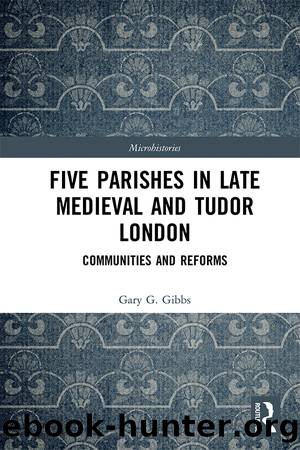Five Parishes in Late Medieval and Tudor London by Gary G Gibbs

Author:Gary G Gibbs [Gibbs, Gary G]
Language: eng
Format: epub
ISBN: 9780429640438
Barnesnoble:
Publisher: Taylor & Francis
Published: 2019-06-18T00:00:00+00:00
Further evidence of devotion
In analyzing the spiritual transformation of the parish, another salient point must be considered: the parishioners were never monolithic in their beliefs. Beyond the diverse pieties established thus far, there were others in the neighborhood. The Coleman Street area served as a home for Lollards, and a small group of them met in Bird Alley at the home of a tailor early in the reign of Henry VIII.76 Furthermore, parishioner Henry Waltonâs will, probated in Londonâs Consistory Court on 13 December 1539, has been cited as manifesting a Lutheran dedicatory formula, the first for London.77 Several parishioners agitated for further reform of the Church in the Elizabethan era.78 In the 1620s, parishioner John Etherington was accused of being a Familiarist.79 Yet the parish continued to operate in the legally expected fashion throughout the Tudor era. As has been noted, Sir Richard Kettell served as vicar without interruption from 1530 until 1562, but Tudor-era clerics could weather such storms.80
At first glance it might seem that little of this parishâs history foreshadows Christopher Hillâs judgment of Saint Stephen as being the most radical puritan parish in the early Stuart era except that it all did; parishioners exercised a busy, fervent parish religion in a community filled with many people who lived in insecure social situations. And, of course, the theological transformation must be analyzed against the basic social continuity. The organization of the parish, especially the changes between 1580 and 1590, witnessed the creation of a semi-Presbyterian parish structure that operated within the larger episcopal system. This structure mattered. As Murray Tolmie wrote, âOf all London parishes, St Stephen Coleman Street was the best qualified to undertake the experiment of an explicit parochial congregationalism.â81 Parishioners demanded an âemphasis on consent and consultation,â which would lessen, but not eradicate, the power of bishop and archbishop over the local church.82 For Saint Stephen Coleman Street, the successful move toward a more autonomous parish that controlled its own benefice can be documented. By the 1580s, the parish had established a lectureship, staffed by William Welles, who also preached at Christ Church Newgate, and he (and the parish) made a qualified subscription to Whitgiftâs Visitations Articles of 1583â84, accepting royal supremacy, but not the Thirty-Nine Articles, and qualifying their use of the prayer book.83 No sermons survive, but Welles had a license to preach his own sermons.
Download
This site does not store any files on its server. We only index and link to content provided by other sites. Please contact the content providers to delete copyright contents if any and email us, we'll remove relevant links or contents immediately.
| Africa | Americas |
| Arctic & Antarctica | Asia |
| Australia & Oceania | Europe |
| Middle East | Russia |
| United States | World |
| Ancient Civilizations | Military |
| Historical Study & Educational Resources |
Room 212 by Kate Stewart(4968)
The Crown by Robert Lacey(4695)
Endurance: Shackleton's Incredible Voyage by Alfred Lansing(4635)
The Iron Duke by The Iron Duke(4258)
The Rape of Nanking by Iris Chang(4108)
Joan of Arc by Mary Gordon(3987)
Killing England by Bill O'Reilly(3931)
Say Nothing by Patrick Radden Keefe(3850)
I'll Give You the Sun by Jandy Nelson(3334)
Shadow of Night by Deborah Harkness(3268)
Hitler's Monsters by Eric Kurlander(3245)
Mary, Queen of Scots, and the Murder of Lord Darnley by Alison Weir(3126)
Blood and Sand by Alex Von Tunzelmann(3106)
Darkest Hour by Anthony McCarten(3042)
Eleanor & Park by Rainbow Rowell(3011)
Margaret Thatcher: The Autobiography by Thatcher Margaret(3010)
Red Famine: Stalin's War on Ukraine by Anne Applebaum(2849)
Book of Life by Deborah Harkness(2841)
The One Memory of Flora Banks by Emily Barr(2752)
